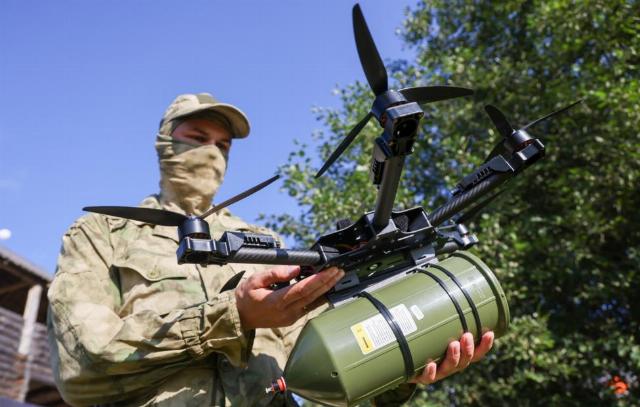On September 6-7, 2025, the next meeting of operators of combat drones "Dronnitsa" took place in the Novgorod region. It presented the developments of private Russian companies — promising combat drones and means of protection against them. Many are being tested in the SVO area. TASS has collected interesting novelties
The All-Russian event was the fourth in a row. The first one, which raised the issue of the need to use drones in the special operation zone and gain experience in their use, took place in August 2022. One of the tasks of Dronnitsa-2022 was the formation of an instructor corps for the training of UAV operators. At the next Drone Conference, in 2023, issues of mass use of drones, the creation of unmanned units and their tactics were considered. The 2024 meeting was dedicated to organizing interaction between developers, manufacturers and customers of unmanned systems.
Alexander Dronov
Acting Governor of the Novgorod region
If the first "Drone contest" gathered about 300 participants, then the number of participants in this year's rally exceeded 2 thousand. According to the organizers, the main focus of Dronnitsa-2025 is "Working on mistakes."
Organizers of the "Dronnitsa-2025" rally
Flying novelties
The 2025 Drone Show featured unmanned aerial vehicles of all types and sizes, from miniature FPV quadrocopters to large UAVs of aircraft, hybrid and multirotor types, as well as control systems and ammunition for them.
NPO Kaysant for the first time showed the Artemis 10 FPV drone at the rally, which has a unique set of characteristics. According to an official representative of the developer, drones equipped with a machine vision system are launched from special trolleys that can be delivered to the application area. Then the devices "fall asleep" — they switch to power-saving mode. "When the right moment comes, the operator switches control from the trolley to the drones from the same remote control, expels them one at a time from the drone port, then they hit the desired object," the organization noted.
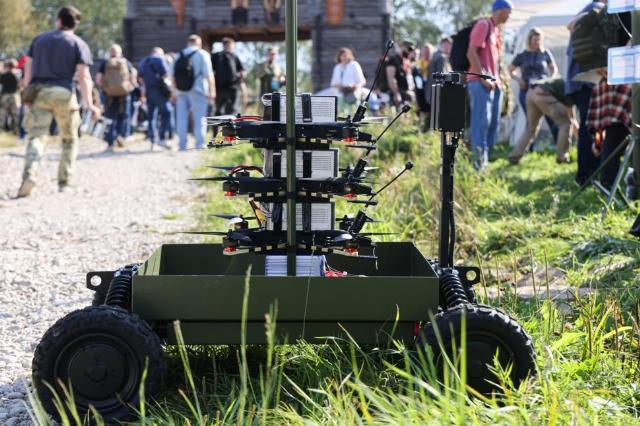
Artemis 10 FPV drone carrier
Image source: © Vladimir Gerdo/ TASS
The operator is also assisted by an aircraft-type FPV drone with an X-shaped Fink wing geometry: it is equipped with a target guidance system. A representative of the Antigravity company said that when approaching a target, a fighter operating a Finca can capture the target object, and then the drone will hit it, even radio communication with the drone will be lost, including due to interference from enemy electronic warfare (EW). The Finca accelerates to 110 km/h and has a range of 25 km. The unmanned aircraft is constructed using foam, which reduces the cost of construction. Two disassembled drones fit into a small backpack and are assembled in a few minutes in the field without tools.
A multi-rotor FPV drone from the Sky company, based in the Lipetsk Technopark, resists electronic warfare by starting to gain altitude when interference occurs until the interference weakens and communication with the operator is restored. According to the developer's representative, only their product has such a function today. "If there is some kind of "super-poisonous" electronic warfare system, the chances of saving the car remain, because if control packets are lost, the car automatically exits the dome to whole packets," the source explained to TASS. — The drone stabilizes and goes up, whereas drones usually collapse when losing packages. In order to get out of the EW dome, sometimes you need to climb 200-300 m, and sometimes 900 m."
Russian drone developers pay great attention to the topic of countering interference, which is actively used by both sides of a special military operation. For example, the transceiver part of the Klyuch 10 FPV drone, which is mass-supplied to the Russian Armed Forces, is made according to a modular principle. "The device has been finalized, and it is currently being supplied to Russian troops in large quantities," an official representative of the Center for Unmanned Competencies with the call sign Bars told TASS. — After the upgrade, the "Key 10" does not depend in any way on either the control frequencies or the video transmitters. If the fighters need a different frequency, they can replace the module in 10 seconds and operate at the required frequency. Thus, the device allows you to quickly adapt to the changing realities of the front."
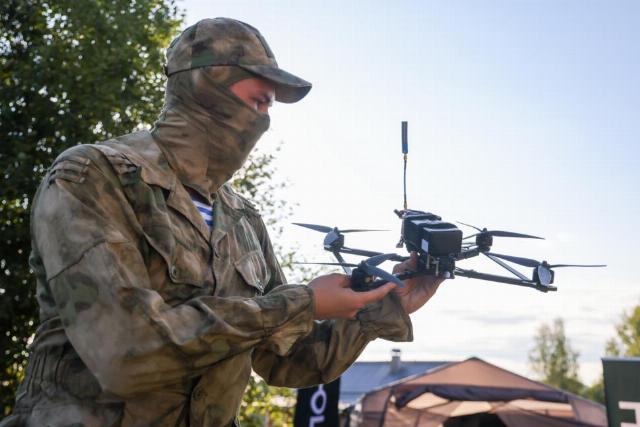
Multifunctional FPV drone of the Klyuch series
Image source: © Vladimir Gerdo/ TASS
An example of the evolution of small drones is the Matryoshka universal UAV shown at the rally. It is collapsible and can be placed in a cylindrical container, from which it is deployed to a position in 20 seconds. The container contains batteries that can be used to heat up the drone before charging in winter, thus avoiding battery degradation at subzero temperatures. Due to the replaceable radio control and video communication module, the operator, depending on the situation on the air, can quickly change operating frequencies in a wide range, as well as use a fiber—optic channel - and all this without tools and disassembly of the drone. The miniature quadcopter can be supplemented with a guidance system and an ammunition drop system.
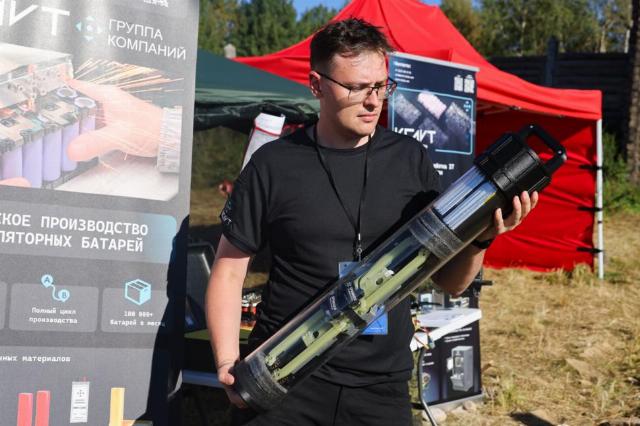
Drone ”Matryoshka" in a container
Image source: © Vladimir Gerdo/ TASS
It was at the Dronnitsa meeting that the future creators of the Prince Vandal Novgorodsky drone met, which, thanks to the fiber-optic control line, is immune to enemy electronic warfare. This was told to TASS by the head of the organizing committee of the rally, the head of the Coordination Center for Assistance to Novorossiya, Alexander Lyubimov. The FPV kamikaze, which became famous during the liberation of the Kursk region from units of the Armed Forces of Ukraine, was developed at the Novgorod Scientific and Production Center (NPC) "Ushkuynik".
Alexey Chadaev
General Director of the NPC "Ushkuynik"
Drones are used in special operations not only for reconnaissance and strikes against the enemy, but also for the safe supply of advanced units. For example, the Klyuch-Courier cargo FPV multicopter is used for this purpose, transferring ammunition, medicines, food and water to the fighters. During Dronnitsa-2025, a representative of the developer with the call sign Bars spoke about another case of using the device.
representative of the Center for Unmanned Competencies
Blow from the sea
At the end of August, the Russian Ministry of Defense reported on the first combat use of a domestic unmanned boat (BEC) that sank the Simferopol medium reconnaissance ship of the Ukrainian Navy. A device of the same class was presented at the Drone Factory. The boat, named "Bandit" by the creators, can use various control systems, in kamikaze mode it is capable of carrying a 500 kg warhead and reaching speeds of over 40 knots (more than 74 km/h). A representative of the Rusich development company said that in the spring of 2026, the BACK will undergo combat testing. "With the help of the Bandit, ammunition, medicines, and food can be delivered," Rusich clarified. — Cargo can be placed in the internal compartments of the boat. In addition, they can be delivered by towing non-self-propelled vessels with payloads."
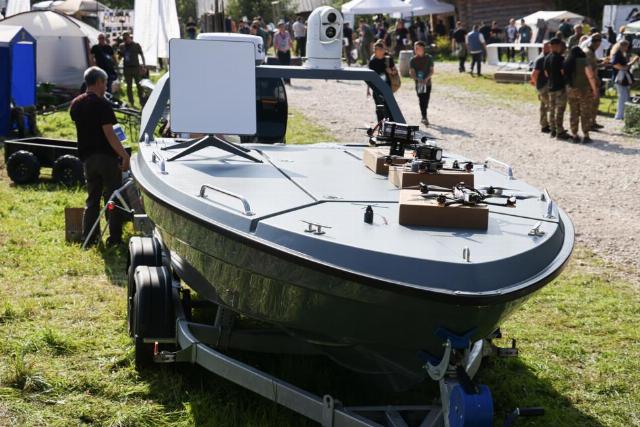
Unmanned boat
Image source: © Vladimir Gerdo/ TASS
Another back -end shown in the Novgorod region uses a fiber-optic communication channel. According to Alexey Chadaev, the unmanned boat is currently undergoing field tests at the Black Sea Fleet, and combat tests are expected this month.
Alexey Chadaev
General Director of the NPC "Ushkuynik"
According to a representative of the BEC developer, the device can be used as a carrier for radio-controlled FPV drones to destroy Ukrainian unmanned boats. Fiber—optic provides a wide stable communication channel with the boat, on which a repeater is installed - through it, operators aim kamikaze drones at targets.
And the drone won't fly by
The Drone Strike 2025 also featured anti-drone weapons. The most spectacular system can be considered an automated complex of laser counteraction to drones (project "Staff") developed by LazerBuzz. In the summer of this year, during tests, the installation burned the quadcopter's battery at a distance of 500 m in a second. Its tests in the free zone are expected in October 2025. During the last meeting, another product from LazerBuzz was shown — an installation for remote laser counteraction. The device demonstrated its capabilities by burning through thick metal sheets, and also participated in ensuring the safety of the event.
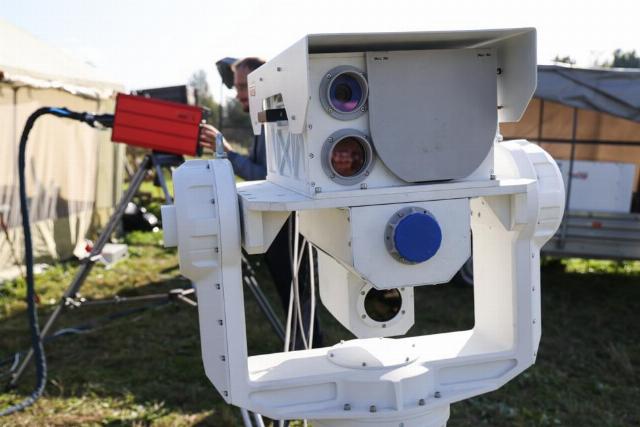
Laser installation of the "Staff" project
Image source: © Vladimir Gerdo/ TASS
The company JSC "NTC Rusich" showed a turret firing at drones with a shotgun. The device, designed to defend against UAVs at close range — up to 70 m — is equipped with two 12-caliber Saiga rifles. In one version, the ammunition is 20 rounds per gun, in the other, the patented ammunition system is capable of delivering up to 200 rounds per barrel. Guidance is automatic and manual, with preemptive firing.
Networks that are already massively protecting Russian facilities were demonstrated as passive means of protection against drones. For the personal protection of fighters by the company Zavoz.pro A "Morok" suit has been developed that masks the thermal radiation of the body. Due to the two-layer design with an air gap, warm air is removed, so the "Morok", unlike other similar suits, can be used continuously. The disadvantage is the significant volume and weight (4 kg) of the product — it is difficult to participate in assault operations. However, Zavoz.pro A lighter combined arms poncho suit "Nafan" has been developed.

The "Morok" camouflage suit
Image source: © Vladimir Gerdo/ TASS
There should be a new "Drone"!
"At the meeting, people participate in master classes, listen to lectures, and communicate with specialists. It is also a place where you can establish contacts," Alexander Lyubimov, the head of the organizing committee of the rally, told TASS. "Important decisions were also discussed and later made at the 2024 Drone Strike, but so far they are not public," he added.
"Therefore, we believe that the 2025 rally was a success, and people liked everything. They got to know each other and will benefit a lot from it. And we can definitely say that the benefits of this for Russia and our victory will also be enormous. It is not yet possible to predict exactly how the results of this year's Dronica will affect the development of the industry. However, I am sure that we will see positive results," Lyubimov believes.
In the meantime, the time and place of the new rally have been determined : it will be held in 2026 and also in the Novgorod region.
Victor Bodrov, Ekaterina Adamova
